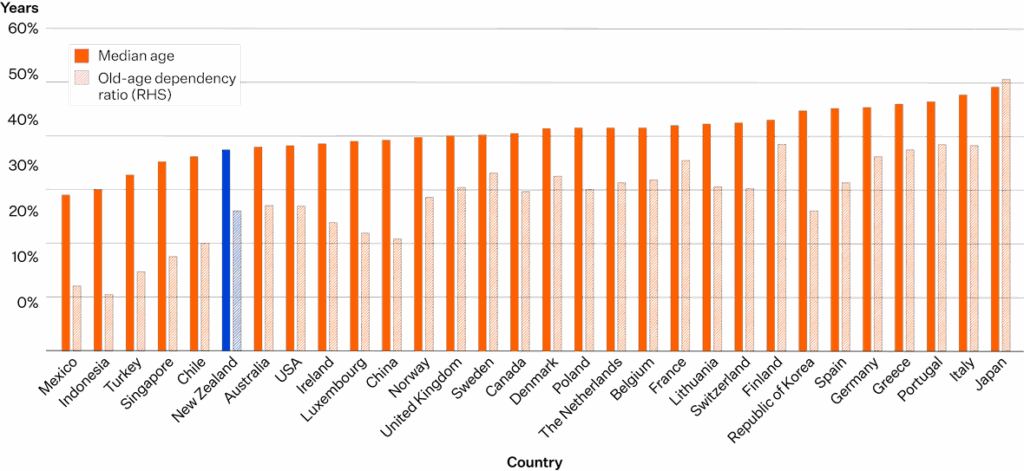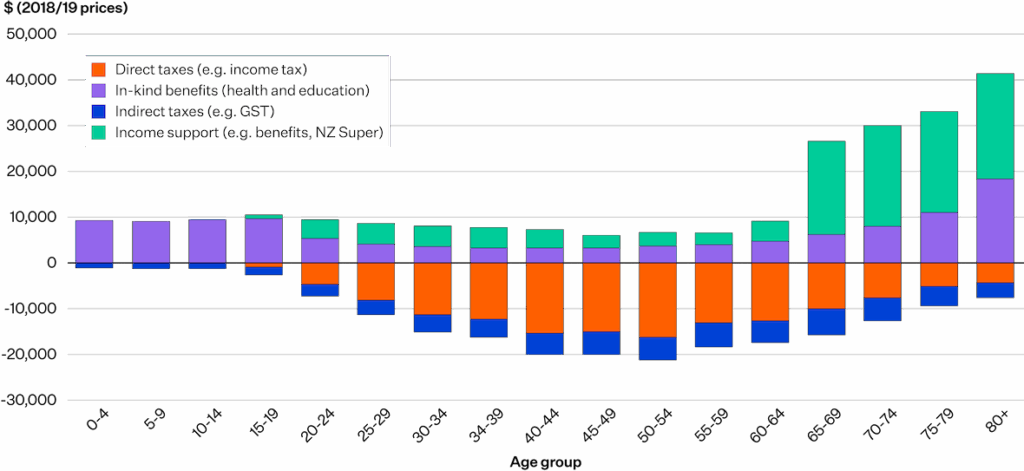A global shift: From youth to ageing populations
As global life expectancy continues to rise, the world is undergoing a profound demographic transformation. In 2023, people aged 50 and above outnumbered those under 15 for the first time. By 2050, over 1.6 billion people will be 65 or older (United Nations Department of Economic and Social Affairs, 2023, p. 19).
This shift has major implications for health, the economy, and public policy. Countries like Japan are set to see the old age dependency ratio (the proportion of people aged 65+ compared to those of working age) exceed 50%, doubling from historical norms.

Source: New Zealand Treasury
The longevity economy: Turning ageing into opportunity
The “longevity economy” is defined by the rising economic and social participation of people aged 50 and above; in 2020, this demographic contributed USD 45 trillion to global GDP, around 34% of total GDP. That figure is only growing, especially as older adults become a key force in emerging consumer markets, particularly in emerging markets.
Far from being a burden, ageing populations could become one of the greatest untapped assets for innovation, productivity, and social progress.
Healthspan vs lifespan: The challenge of healthy ageing
Although people are living longer, many spend their final decade in poor health. Health-adjusted life expectancy is not keeping up with chronological longevity. This disconnect poses a significant barrier to realising the benefits of the longevity economy.
To tackle this, the McKinsey Health Institute proposes six key strategic shifts:
- Promote healthy ageing through preventive approaches
- Improve health measurement and real-time data use
- Scale evidence-based interventions
- Accelerate cross-sector innovation
- Unlock contributions across all industries
- Empower older adults to stay engaged and productive
These shifts must span all four dimensions of health: physical, mental, social, and spiritual. For instance, the Okinawan model shows how diet, movement, social connection and purpose contribute to a thriving older population.

Source: Deloitte
Preventive health and policy reform: A crucial pivot
Most high-income nations still invest disproportionately in late-stage medical care. Yet only about 10% of preventable deaths in high-income countries are linked to deficiencies in medical treatment; far more are related to behavioural and social determinants.
Public Health Policy must pivot from reactive treatment to proactive prevention, supporting lifelong health. This includes investing early, enabling younger generations to age well. As the UK Economic Observatory notes, today’s children have a one in six chance of living to 100. The goal? Ensure they arrive at old age healthier, wealthier, and ready to contribute.
Reimagining work and retirement
Labour force participation among older adults is on the rise globally. In New Zealand, older adult employment has increased significantly, helping offset fiscal pressures from an ageing population.
Each additional year of working life is estimated to boost GDP by 1%. But raising the retirement age alone isn’t enough. We need:
- Lifelong education
- Flexible employment options
- Age-inclusive workplaces
These are essential to ensuring older adults can remain active contributors to society.

Source: Brookings Institution
Fiscal sustainability: Reforming transfers and care funding
Modelling suggests that aging could push New Zealand into unsustainable debt without policy reform unless mitigated by higher productivity and labour force participation among seniors. Currently, public transfers to seniors far exceed the tax contributions of this demographic.

Source: New Zealand Treasury
This underscores the urgency of reforming pension systems and long-term care funding. Fiscal sustainability must go hand in hand with wellbeing, ensuring social cohesion across generations.
The road ahead: A new vision of ageing
The rise of the longevity economy presents both a challenge and a once-in-a-generation opportunity. By aligning data, innovation, and policy around a long-term vision of health and purpose, we can:
- Extend lifespan while compressing years lived in poor health
- Empower older adults as contributors, not dependents
- Foster equity across generations
Success will require a holistic rethinking of ageing, not as a decline, but as an era of potential.



